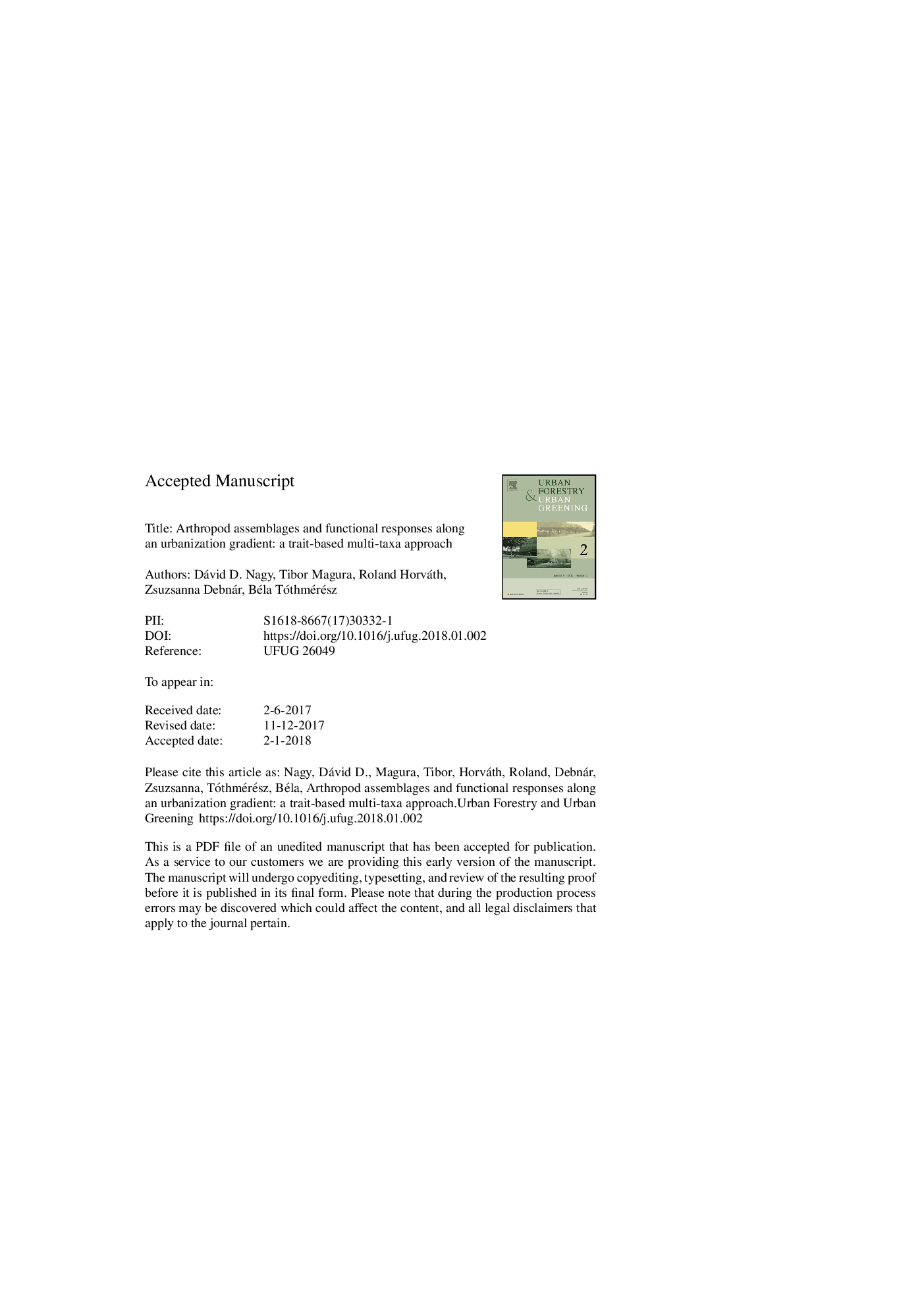| کد مقاله | کد نشریه | سال انتشار | مقاله انگلیسی | نسخه تمام متن |
|---|---|---|---|---|
| 6549430 | 1421860 | 2018 | 29 صفحه PDF | دانلود رایگان |
عنوان انگلیسی مقاله ISI
Arthropod assemblages and functional responses along an urbanization gradient: A trait-based multi-taxa approach
ترجمه فارسی عنوان
مجموعه های آرتروپو و پاسخ های عملکردی در راستای شیب شهری: یک رویکرد چند منظوره مبتنی بر صفات
دانلود مقاله + سفارش ترجمه
دانلود مقاله ISI انگلیسی
رایگان برای ایرانیان
کلمات کلیدی
ترجمه چکیده
شهرنشینی باعث تغییر قابل توجهی در طیف وسیعی از توابع اکوسیستم در مقیاس های منطقه ای و جهانی می شود. این تغییرات می تواند ریشه های اصلی ثبات زیستگاه و خدمات اکوسیستم در فضای سبز شهری باشد. هدف از این مطالعه، بررسی تأثیر شهرنشینی بر تنوع تاکتیکی و عملکردی بندپایان در سطوح مختلف تناوبی است. ما از عنکبوت های خرچنگ، سوسک های چند نژادی و جمع آوری زباله های چوبی در کنار یک گرادیان روستایی-حومه-شهری جمع آوری کردیم. نه تنوع زیستی و نه تنوع عملکردی (آنتروپی درجه دوم رائو) با استفاده از ویژگی های مورفولوژیکی (اندازه بدن) و ویژگی های زیست محیطی (وابستگی زیستگاه، رطوبت، و حساسیت اختلال) عنکبوت ها در طول گرادیان شهری متفاوت بود. برای سوسک های سوسک، تنوع تاکسونومی در مناطق روستایی نسبت به مناطق حومه و شهری بسیار بیشتر بود، در حالی که تنوع عملکردی بین سایت ها به طور قابل توجهی تفاوت نداشت. هر دو تنوع گونه ای تاکسونومیک و عملکردی چوب زیتون در مکان های روستایی به طور قابل توجهی بیشتر از محل های حومه یا شهری بود. تجزیه و تحلیل مکاتبات کاننیکس نیز نشان داد که شهرنشینی تغییرات مهمی در ترکیب سازه های عنکبوت ایجاد نمی کند، در حالی که مونتاژ سوسک و سوسک های چوبی نشان می دهد که مناطق روستایی و شهری مشخص شده است. این مطالعه نشان می دهد که سطوح طرحی ممکن است یک راننده مهم در پاسخ به شهرنشینی باشد. نتایج ما نشان می دهد که شهرنشینی تأثیرات مضرتری بر عنکبوت های خربزه دارد، چرا که آنها به آسانی می توانند فضای سبز شهری را مدیریت کنند. به طور خلاصه، احیای پرتوی قطره چکان در سطح مقطع پایین تر (سوسک و سوسک) به زیستگاه های شهری بطور قابل توجهی محدود می شود.
موضوعات مرتبط
علوم زیستی و بیوفناوری
علوم کشاورزی و بیولوژیک
جنگلداری
چکیده انگلیسی
Urbanization causes considerable alteration across a wide range of ecosystem functions at regional and global scales. These changes could be key drivers of habitat stability and ecosystem services in urban greenspaces. The aim of this study was to test the influence of urbanization on taxonomic and functional diversities of arthropods of different trophic levels. We collected predator spiders, polyphagous rove beetles, and decomposer woodlice along a rural-suburban-urban gradient by litter sifting. Neither the taxonomic, nor the functional diversity (Rao's quadratic entropy) using a morphological trait (body size) and ecological traits (habitat affinity, humidity preference, and disturbance sensitivity) of the spiders were significantly different along the urbanization gradient. For rove beetles, taxonomic diversity was significantly higher in rural sites compared to suburban and urban ones, while functional diversity did not differ significantly between sites. Both the taxonomic and the functional diversities of woodlice were significantly higher in the rural sites than in the suburban or urban sites. Detrended canonical correspondence analysis also showed that urbanization did not cause considerably changes in composition of spider assemblages, while rove beetle and woodlouse assemblages showed clear separation between rural and urban sites. This study pointed out that trophic levels may be a crucial driver of the responses to urbanization. Our results suggest that urbanization has a less harmful effect on predator spiders, as they can easily recolonize the managed urban greenspaces. Contrarily, recolonization of arthropods at lower trophic levels (rove beetles and woodlice) into the urban habitats is considerably restricted.
ناشر
Database: Elsevier - ScienceDirect (ساینس دایرکت)
Journal: Urban Forestry & Urban Greening - Volume 30, March 2018, Pages 157-168
Journal: Urban Forestry & Urban Greening - Volume 30, March 2018, Pages 157-168
نویسندگان
Dávid D. Nagy, Tibor Magura, Roland Horváth, Zsuzsanna Debnár, Béla Tóthmérész,
